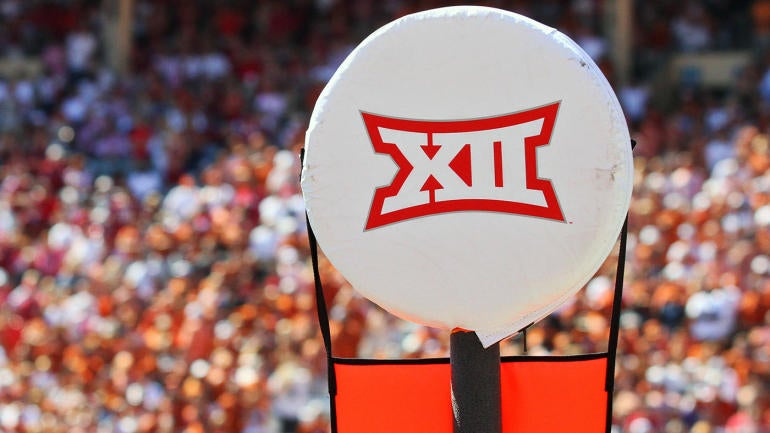
The Big 12's expansion plans are coming into focus following the sudden departures of Texas and Oklahoma to the SEC this summer. The Big 12 is prepared to invite BYU, Cincinnati, Houston and UCF to join the conference in the near future if league presidents vote in the affirmative at a planned meeting this coming week, sources tell CBS Sports' Dennis Dodd.
The four teams may be able to join the Big 12 prior to the scheduled departures of Texas and Oklahoma in 2025.
The three programs that are currently members of the American (Cincinnati, Houston, UCF) must provide the conference with 27 months notice ahead of their departures; they would each be required to pay a $10 million early termination fee, though both terms are negotiable, according to AAC commissioner Mike Aresco.
BYU is currently operating as an independent and could join the Big 12 without significant notice.
Texas and Oklahoma must give 18 months notice to the Big 12 if they plan to leave the conference before their grant of rights agreement ends in 2025. Two years of revenue distribution, approaching $80 million per team, would also go to the Big 12.
The goal of the four-team expansion would be to push the league back to its original 12-member alignment with the four aforementioned teams combining to fill a portion of the vacuum created when the league's top two programs (Texas and Oklahoma) dropped the Big 12.
The Big 12 just wrapped up two days of meetings in which conference decision-makers focused on future membership.
"Following two days of consultation with the athletics directors of the continuing members of the Big 12 conference," commissioner Bob Bowlsby said Wednesday. "The eight ADs remain committed to furthering the Big 12 as one of the nation's premier athletic conferences, and look forward to working with our presidents and chancellors to strengthen the league. Future exploration by the group will continue to center on options that best position the long-term strength of the conference."
Should BYU, Cincinnati, Houston and UCF accept bids to the Big 12, the conference may allow Texas and Oklahoma to leave before their contractual rights are up in 2025. That would only be a possibility if the remaining eight Big 12 schools are made whole financially from the current media rights deal ($37 million per school).
For the four schools invited to the Big 12, the move would be a giant step revenue-wise. American schools currently average $7 million in media rights revenue annually. Big 12 schools currently average $37 million annually.
Industry sources tell CBS Sports that the Big 12 lost at least 40% of its value with the departure of Texas and Oklahoma. However, the reconfigured Big 12 with four additions could earn $20 million-$25 million per season, softening the financial blow.
"These are the four that will allow us to enter that future negotiation favorably," a source within the Big 12 said. "What we're trying to do will give us the best opportunity to retain our CFP status and our Power Five status."
Bowlsby told CBS Sports last week he does not believe the Big 12 is in danger of losing its authority.
"I don't have any particular reason to be concerned about it," Bowlsby said.
"Power Five" is a brand label that defines not only a football program but an entire university. It can figure into a school's ability to land research grants, hire staff and faculty and even impact enrollment.
One Big 12 source defined continued Power Five status this way: Equal College Football Playoff shares with the other conferences (SEC, Big Ten, ACC, Pac-12) and a spot on the CFP Selection Committee.
Under the current CFP contract, Power Five leagues each receive $66 million for merely participating in the process. The remaining Group of Five leagues split $90 million. Power Five conferences each have a representative on the 13-person committee. The Group of Five conferences (American, Conference USA, MAC, Mountain West, Sun Belt) have a combined two representatives.
Aresco all but confirmed the Big 12's interest in three of his league's teams, though he did hedge on Friday: "I think you would say they are apparently turning to the American. We don't know what's going to happen next week."
The Athletic's Max Olson first reported the four programs that the Big 12 is targeting, while Action Network's Brett McMurphy first reported that such a move could occur this month.
What does it mean for the Big 12? Here are some potential upsides as it decides its future membership.
Creating presence in key TV markets
Adding the aforementioned four teams wouldn't fill the entire void left by Texas and Oklahoma. However, adding UCF would give the Big 12 a presence in the major television market of Orlando. Cincinnati, meanwhile, would bring more of a Midwest footprint to pair with West Virginia. BYU would add in the Salt Lake City, Utah, market and an international fan base. Houston, of course, would help the Big 12 maintain a strong presence in Texas, even though the most prominent team in the Lone Star State is leaving and the second-most prominent (Texas A&M) departed in the last round of realignment.
Television markets may not be driving this round of realignment, but major cities with passionate fan bases do make a difference when it comes to deciding which teams to add. It'll give the Big 12 a nice portfolio to sell to potential distributors -- both traditional and over-the-top streaming.
Maintaining high levels of competition
The four programs being eyed by the Big 12 have achieved significant success as Group of Five members over the last decade. None of them have reached Oklahoma's level in terms of College Football Playoff appearances, but they have been every bit as competitive as the Longhorns, if not more so.
BYU and Cincinnati are coming off of all-time great seasons. The Cougars finished 11-1 with a No. 11 final ranking in 2020 and produced the No. 2 overall pick in the NFL Draft, quarterback Zach Wilson. The Bearcats enjoyed an undefeated AAC championship run and fell just short against Georgia in the Peach Bowl. Coach Luke Fickell is considered one of the top coaches in the country and will almost certainly be a top target by Power Five schools once the coaching silly season starts.
UCF has also enjoyed success as a college football juggernaut. The Knights had three straight seasons of double-digit wins from 2017-19, going undefeated in 2017 and winning 12 straight games as a follow-up in 2018. Before that, Houston was the class of the AAC, going 13-1 and beating Florida State in the Peach Bowl during the 2015-16 season.
That high level of play is important if and when the 12-team playoff comes into existence. The current agreement, after all, is for the top six conference champions to receive an auto bid.
Building in recruiting advantages
If the Big 12 is going to expand, it might as well help the conference as a whole when it comes to recruiting. Moving into cities like Houston, Orlando, Salt Lake City and Cincinnati would give each team in the conference a chance to play in front of a ton of high school players in talent-rich areas.
For example: Florida currently has 16 of the top 100 prospects in the Class of 2022, per the 247Sports Composite, while the state of Ohio boasts four and Utah has one. That's 20 of the top 100 prospects in the new states that they are reportedly targeting in addition to the 15 that are already in the state of Texas.





















